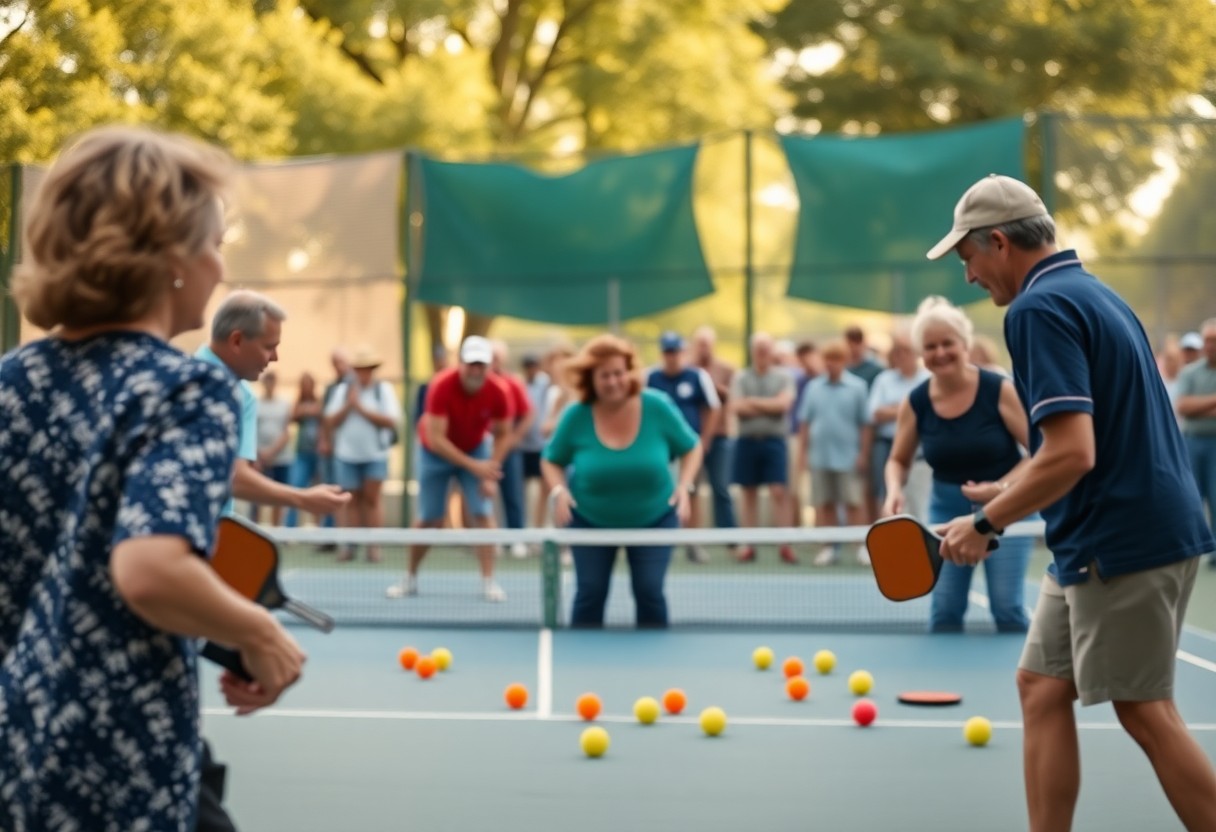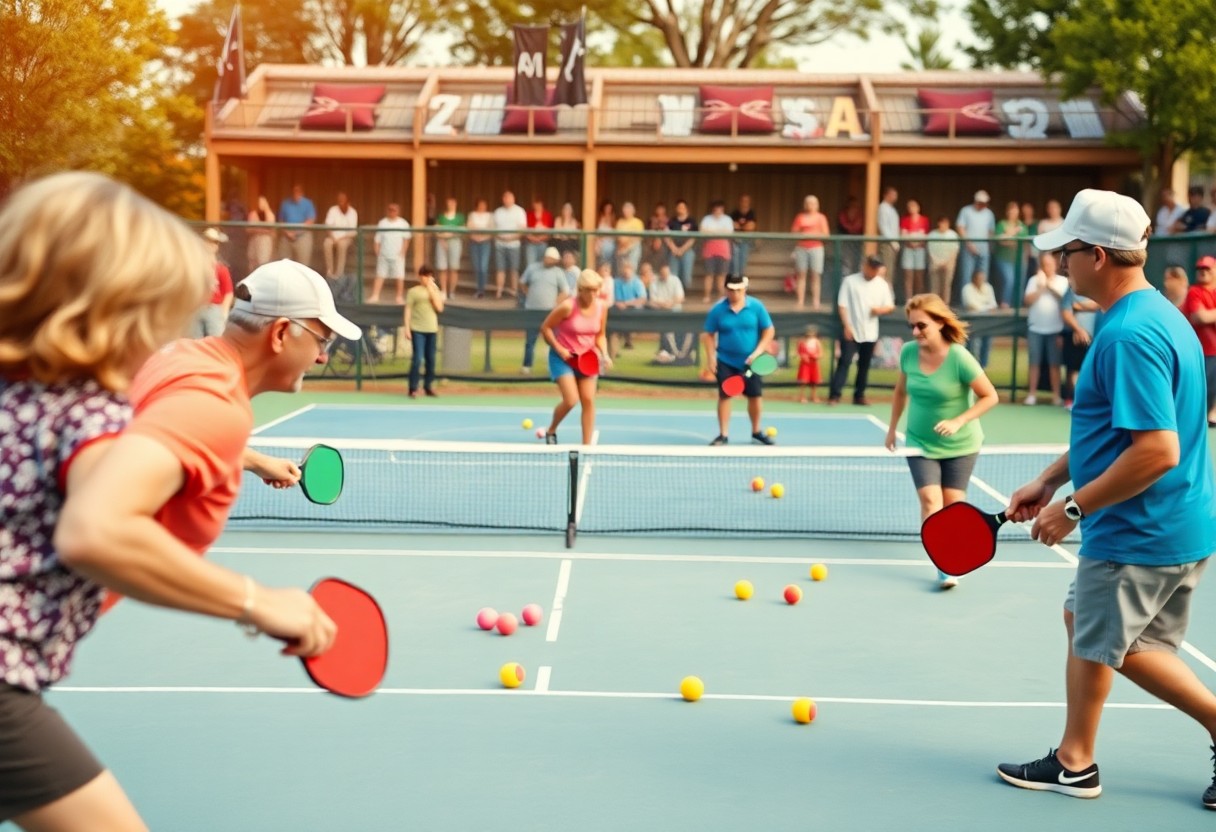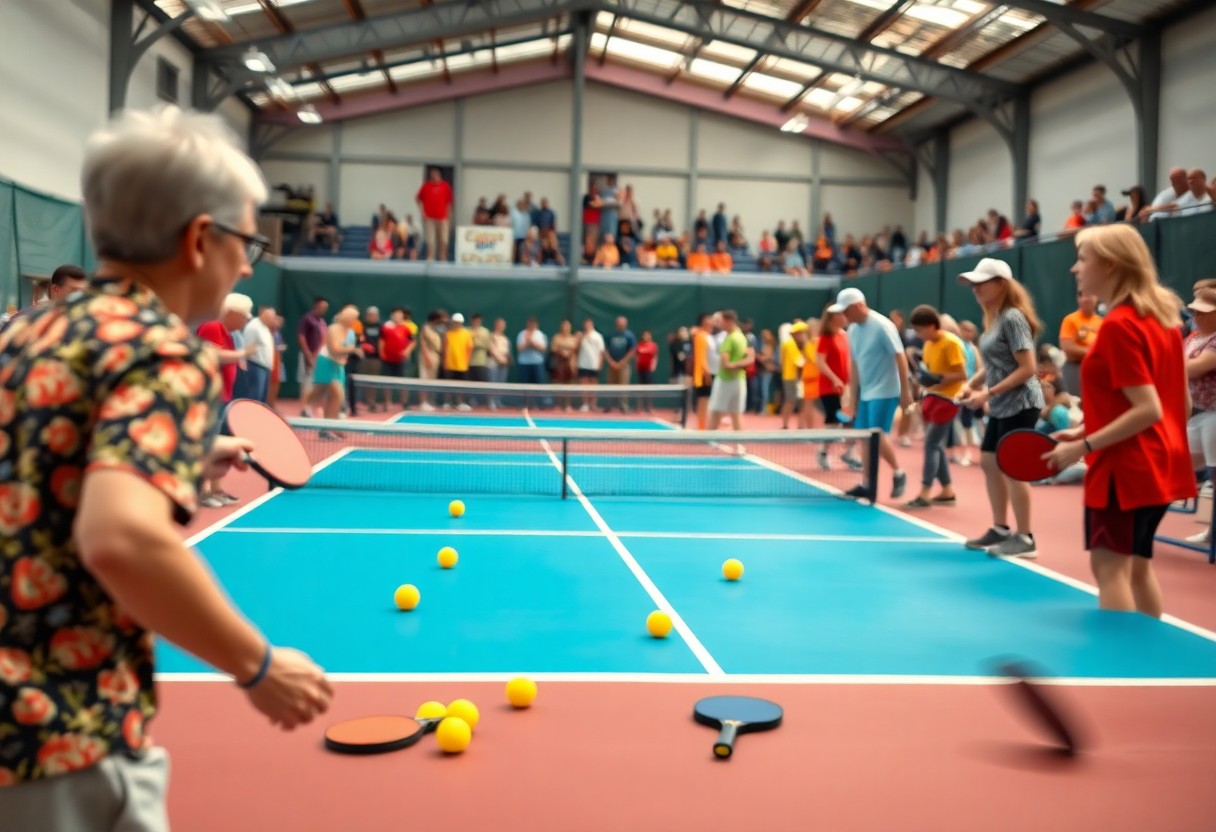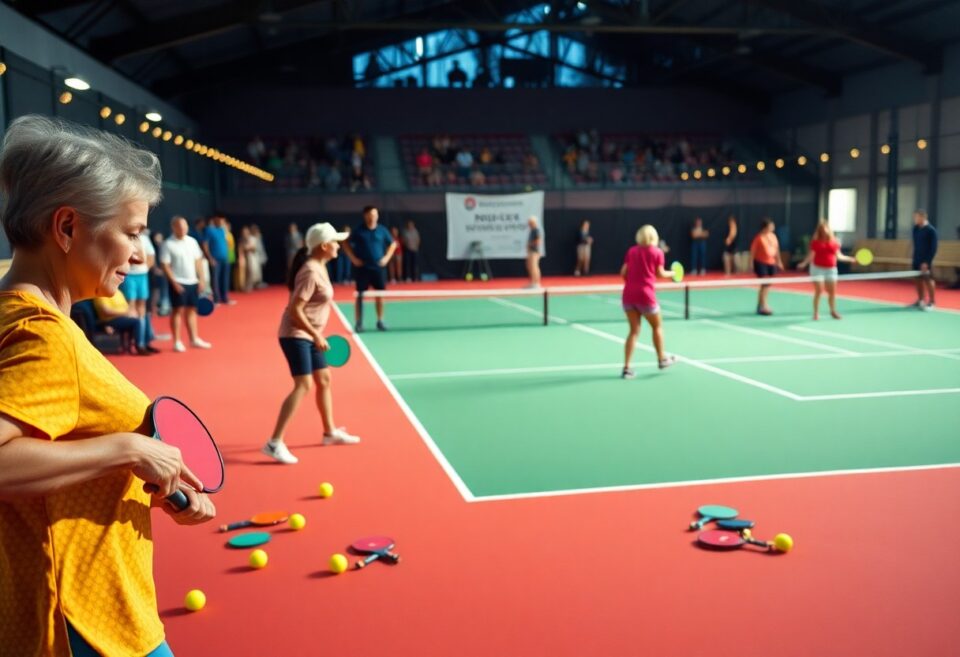It’s easy to see why pickleball is capturing the attention of players across all ages. You might wonder what makes this sport so appealing and how it has expanded at such an unprecedented rate. Pickleball combines elements of tennis, badminton, and ping-pong, creating a game that’s accessible and enjoyable for everyone, from beginners to seasoned athletes. The fast-paced action and social nature of pickleball offer you a fantastic way to stay active and connect with others. Understanding its unique features will help you appreciate why this sport continues to grow exponentially.
The Dynamic Appeal of Pickleball
One of pickleball’s most remarkable qualities is how it blends the intensity of competitive sports with a friendly, social atmosphere. This balance allows you to engage in a fast-paced, strategic game that demands quick reflexes, sharp hand-eye coordination, and tactical thinking. Despite the game’s speed, the smaller court size and underhand serve mean your swimming skill level or general athleticism doesn’t have to be elite. This creates a playground for players of varying skill levels to thrive, whether you’re a seasoned athlete or just starting out.
Another dimension of pickleball’s appeal lies in the rhythm and flow of gameplay. Rallying back and forth at high speed, the game encourages constant movement paired with bursts of explosive energy, making it a fun and effective cardiovascular workout. Unlike some racquet sports that can feel solitary or segmented, pickleball’s doubles format fosters teamwork and communication, often sparking immediate camaraderie. If you enjoy dynamic socializing mixed with your physical activity, pickleball serves both your body and your need to connect with others.
Besides the physical and social benefits, pickleball’s culture promotes inclusivity and community. Local clubs and national tournaments bring together a diverse range of players—from young children honing new skills to retirees savoring an active lifestyle. This inclusive environment helps sustain your motivation to improve while enjoying the sport without judgment or pressure. As you step onto the court, you’re joining a worldwide movement that values fun, fitness, and friendship equally.
A Sport for All Ages: Inclusivity and Accessibility
Pickleball has managed to carve out an unparalleled niche as a sport that truly welcomes everyone. From elementary school PE classes to senior centers, the game is adapted to suit the physical abilities and preferences of players across the age spectrum. Its court resembles a smaller version of a tennis court, which you’ll find less daunting to navigate, especially if mobility is a concern. The reduced court size means the distances you’re required to cover are manageable regardless of your age or fitness level.
Social and recreational pickleball leagues often feature mixed-age teams, allowing you to learn from players of different generations while enjoying the shared joy of competition. The sport’s rules are straightforward, helping you or your loved ones pick up the game quickly. Moreover, many communities have embraced pickleball’s accessibility by providing inclusive programming that caters to players with physical limitations or disabilities. Additional adaptive equipment and modified rules are commonplace, making participation a real possibility instead of just a distant dream.
Families have also embraced pickleball as a multigenerational pastime that facilitates bonding and active time together. You can find youth clinics designed to build foundational skills alongside adult mixers that emphasize fun over fierce rivalry. The sport’s reputation for being a gentle, low-impact workout makes it an excellent choice for those who want to stay active without risking the joint strain found in high-impact sports. Ultimately, pickleball offers you and your family an activity that fosters healthier habits while nurturing community ties.
Low Barrier to Entry: Equipment and Learning Curve
Getting started with pickleball doesn’t require you to invest in costly gear or extensive training. All you need is a paddle, a pickleball, and access to a court, many of which are public or shared spaces in your community parks. Paddles typically cost between $20 and $150, with beginner-friendly options available at the lower end, allowing you to experience the game’s satisfying control and bounce without a steep financial commitment. The balls themselves are made of durable plastic with holes, specially designed to float and slow the pace to a manageable speed.
The simplicity of pickleball’s rules also means you don’t spend hours learning complicated techniques or foul regulations before hitting the court. Your initial focus can be on mastering fundamental skills such as serving, volleying, and scoring, which are straightforward and quickly picked up by most newcomers. Many local clubs and recreation centers offer beginner workshops and open-play sessions that give you ample opportunity to practice in a low-pressure environment, accelerating your progress and enjoyment.
Even the court setup is highly flexible—many existing tennis courts have been adapted with pickleball lines, and portable nets allow you to transform nearly any flat surface into a viable pickleball court. These factors collectively lower the barriers for you to try and sustain the sport, contributing to the rapid growth seen in urban, suburban, and rural areas alike.
Moreover, the pickleball community fosters a welcoming environment where new players receive guidance and encouragement, making your first experience rewarding and confidence-building. This supportive culture combined with affordable, accessible equipment turns what might be a daunting entry into sports into an inviting and exciting adventure.

The Community Culture: Building Bonds Through Sport
Social Interaction: Fostering Friendships and Networks
The social fabric of pickleball is woven tightly through regular interaction on and off the court. When you step into a pickleball community, you’ll notice an open and welcoming atmosphere that naturally encourages connection. Many players come for the sport but stay for the camaraderie. Local clubs and recreational centers often organize casual play sessions where you can meet others across different age groups and backgrounds, making it easier to form bonds around a shared interest. These connections often extend beyond the game, evolving into genuine friendships that influence your social life in unexpected, meaningful ways.
The diversity of those who play pickleball offers a unique chance to broaden your social circle. Seniors, young adults, and everything in between all share the court, creating a melting pot of experiences and stories. This demographic diversity fosters inclusive interaction and makes it easier to find common ground beyond skill level alone. As you participate regularly, you might find yourself involved in volunteer opportunities, group outings, or even mentoring others, all of which deepen your involvement and further your networking potential.
Social media groups and online forums dedicated to pickleball communities enhance this connection by allowing you to stay engaged even when you’re not playing. These platforms serve as hubs for organizing meetups, sharing tips, and celebrating achievements, reinforcing the social network built through the sport. Many players find that digital interaction complements the physical play experience, offering a continuous sense of belonging and support that keeps them engaged and connected.
Organized Play: Leagues, Tournaments, and Local Events
Leagues and tournaments act as vital pillars within the pickleball community, helping you sharpen your skills and meet a wider group of players. Local leagues typically run seasonally and accommodate various skill levels, allowing you to compete in a structured environment that challenges you without overwhelming you. Organized play offers both a goal and a rhythm to your participation, providing motivation to improve and consistency in social interaction. The sense of progression and achievement in these settings can be highly rewarding, especially as you climb rankings or secure victories.
Sanctioned tournaments, ranging from small grassroots competitions to large regional events, give you a platform to test your abilities under pressure and experience the thrill of competition. Events like the USA Pickleball National Championships attract thousands of players, offering exposure and networking on a grand scale. Meanwhile, local events help communities thrive by encouraging newcomers and fostering friendly rivalries. These gatherings often double as social occasions, complete with clinics, exhibitions, and social dinners, which deepen your immersion in the culture while expanding your contact list.
Community-driven events like pickleball festivals and charity tournaments highlight the sport’s dynamic role beyond the courts, often drawing media attention and local sponsorships. Participating in such events can introduce you to players outside your usual circles and connect you to regional or national pickleball organizations. These broader engagements provide further opportunities for personal growth and community impact, enriching your experience while supporting the sport’s rapid expansion globally.
Whether you take part in a beginner-friendly league, a competitive tournament, or a community fun day, these activities invigorate your involvement and link you to a larger network of enthusiasts. Many cities have seen pickleball become a staple in their recreational calendars, with municipal programs investing in dedicated courts and organized schedules to accommodate the swelling participation numbers. This structured support maximizes your playtime and social opportunities, making organized pickleball not just a sport but a vibrant community cornerstone.
Health Benefits That Turn Heads
Comprehensive Fitness: Cardiovascular and Muscular Benefits
Pickleball offers a workout that engages both your cardiovascular system and muscles without demanding the intensity of high-impact sports. During a typical game, you might cover between 2 to 3 miles, which aligns closely with the recommended daily physical activity for maintaining heart health. This moderate aerobic exercise elevates your heart rate sufficiently to improve circulation and strengthen your heart muscle, all while being gentle on your joints. Unlike running or intense racket sports, the small court dimensions and frequent pauses in play reduce injury risks but still provide substantial aerobic benefits.
Beyond cardiovascular improvements, Pickleball engages multiple muscle groups in your body. Your legs work constantly to position you for each shot, enhancing balance, agility, and lower-body strength. The repeated swinging motion strengthens your shoulders, forearms, and wrists, while the quick changes in direction activate core muscles that stabilize your posture. Over time, this combination of movements builds endurance and tone without the repetitive strain injuries often seen in more strenuous activities. You’re effectively getting a full-body workout that’s accessible for most fitness levels and ages.
Moreover, the intermittent nature of Pickleball—alternating between bursts of activity and brief rests—boosts your metabolism. This pattern not only burns calories during play but can elevate your metabolic rate for hours afterward. Because the game encourages frequent short sprints and lateral movements, it enhances both anaerobic capacity and overall stamina. Whether you’re playing competitively or casually, this blend of cardiovascular and muscular benefits supports long-term physical fitness and weight management with enjoyable, social exercise sessions.
Mental Wellbeing: Stress Relief and Cognitive Engagement
Pickleball isn’t just exercise for your body—it actively stimulates your mind, offering profound mental health benefits. The fast-paced decision-making required during rallies forces you to stay alert and process information quickly, invoking cognitive engagement similar to other strategy-based activities. Studies have shown that such mental challenges can help slow cognitive decline and sharpen executive functions like planning and spatial awareness. Engaging in Pickleball frequently may improve your memory and problem-solving skills, protecting your brain health as you age.
The social aspect of Pickleball also contributes to stress relief and emotional wellbeing. Playing doubles or joining community leagues lets you connect with others, building relationships and fostering a sense of belonging. Social interaction during physical activity has been linked to reductions in anxiety and depression symptoms. As you focus on the game and camaraderie, you experience a dopamine release, which enhances your mood and promotes relaxation. For many, the sport becomes a stress outlet, distracting from everyday worries and providing a structured, enjoyable way to unwind.
Additionally, the rhythmic nature of play combined with the moderate physical exertion leads to lowered cortisol levels, which directly decreases stress. Regular Pickleball sessions act much like meditation through movement. The steady focus on ball placement and scoring can be almost meditative, helping you disconnect from intrusive thoughts and mental clutter. This mind-body harmony cultivates greater emotional balance and resilience against mental fatigue, making your mental recovery as effective as the physical.
The cognitive engagement you gain from Pickleball directly complements its stress-relief effects. As your brain adapts to the quick tactical decisions and hand-eye coordination demands, neural pathways strengthen, promoting sharper concentration and quicker reflexes. This dynamic interaction between physical and mental exercise results in a holistic boost to brain health, with measurable improvements in mood regulation and cognitive flexibility observed in players across age groups. Coupling this with the supportive social environment of Pickleball makes it uniquely effective for enhancing overall mental wellbeing.

The Rising Popularity: Statistical Surge and Media Influence
Participation Growth: Analyzing Recent Figures
Pickleball has experienced an unprecedented surge in player numbers over the past few years, making it one of the fastest-growing sports in North America. According to the Sports & Fitness Industry Association (SFIA), participation in pickleball rose by nearly 21.3% from 2021 to 2023, reaching over 9.1 million players in the United States alone. This explosive growth spans across various age groups, but interestingly, demographics from seniors to millennials have all found appeal in the game’s accessibility and low barrier to entry.
Municipalities and private clubs have responded accordingly by increasing the availability of dedicated pickleball courts. The number of dedicated courts in public parks has more than doubled in certain states such as Florida and Arizona, where retiree communities thrive. This expansion not only provides greater access but also highlights an institutional recognition of pickleball’s value as a community sport capable of uniting diverse groups. Your local parks department might have already allocated resources for new courts as part of broader health and wellness initiatives.
Market data also reveals that equipment sales, including paddles and balls, have surged in tandem with participation rates. In 2023, pickleball paddle sales reportedly increased by over 30%, reflecting rising demand and the sport’s entrance into the mainstream consumer landscape. This growth signals opportunities beyond just playing the game—whether you’re a retailer, coach, or enthusiast, the ecosystem surrounding pickleball is expanding rapidly with vibrant economic activity.
Media Spotlight: How Coverage Catalyzes Interest
Pickleball’s media presence has evolved from grassroots newsletters and local sports channels to widespread national coverage. Major networks such as ESPN and the Tennis Channel have started broadcasting pickleball tournaments, elevating the sport’s visibility to millions of viewers unfamiliar with its rules or culture. These televised matches showcase elite athletes battling it out in high-energy settings, creating a compelling narrative that portrays pickleball as both highly competitive and entertaining.
Social media platforms also play a significant role in shaping pickleball’s image and attracting new players. Viral videos featuring trick shots, community events, and professional athlete endorsements generate strong engagement. TikTok and Instagram users often share beginner-friendly tutorials and highlight reels, making it easier for you to learn and feel connected to the global pickleball community online. Influencers and specialized pages help sustain excitement about upcoming tournaments and gear innovations, amplifying the sport’s momentum.
Local newspapers and lifestyle magazines have embraced pickleball stories, focusing on its community-building aspects and health benefits you’ve already explored earlier. Human-interest pieces profiling players from a variety of backgrounds further humanize the sport and attract diverse interest. This multi-layered media coverage not only informs but also inspires newcomers by illustrating how pickleball can fit seamlessly into your social and physical routines.
Additional insight into media influence reveals that coverage timing aligns closely with participation spikes. For example, when the USA Pickleball National Championships received prime-time airtime in 2023, pickleball club memberships across several states saw a notable uptick in inquiries and sign-ups. This cause-and-effect relationship underscores how strategic media exposure acts as a catalyst, converting casual curiosity into active participation, encouraging you to step onto the court and join the growing ranks of players nationwide.

Overcoming Barriers: Addressing Misconceptions
The Age Factor: Challenging Stereotypes of Athleticism
You might have noticed how pickleball often gets brushed off as a game mainly for seniors, but that’s a stereotype that doesn’t reflect reality. While pickleball is indeed popular among older adults—largely because it’s low-impact and easier on joints than tennis—it is increasingly embraced by players of all ages. The sport requires quick reflexes, strategic thinking, and agility, proving that it’s not just a pastime for those winding down but a competitive and energetic sport suited for everyone. High school and college teams are emerging nationwide, underscoring that your age doesn’t limit your potential to excel in pickleball.
Sporting communities and recreational centers report participation spikes among younger demographics, drawn in by the fast pace and social aspects. The misconception that pickleball is slower or less demanding can hinder people from trying it, yet the rallies can be incredibly intense. You rapidly develop endurance and hand-eye coordination, benefiting your overall athleticism in ways you might not expect. It’s this blend of accessibility and challenge that lets you rewrite what being athletic really means at any age.
Common misconceptions about pickleball and age:
- Myth: Pickleball is only suited for seniors.
- Fact: Worldwide, players aged 10 to 70+ compete actively.
- Myth: It lacks physical intensity.
- Fact: Matches can involve quick lateral movements and sharp reflexes.
- Myth: You don’t build fitness playing pickleball.
- Fact: The game improves cardiovascular health and coordination.
Knowing you can join pickleball regardless of age helps shatter outdated views, inviting you to embrace a sport that’s as competitive and demanding as it is inclusive.
| Misconception | Reality |
|---|---|
| Only for seniors | Active players span all ages, from teens to older adults |
| Low physical demand | Requires agility, endurance, and quick decision-making |
| No athletic benefit | Enhances cardiovascular and muscular fitness |
| Social more than sport | Supports competitive leagues and tournaments globally |
| Simple recreational game | Deep strategies, skill development, and intense play |
Equipment Misunderstandings: Identifying Myths vs. Reality
Many people hesitate to pick up pickleball believing the equipment might be overly specialized or costly, but the truth is far friendlier to newcomers. You don’t need expensive gear or advanced tools to start playing at a casual level. A standard pickleball paddle is lightweight and ergonomically designed, quite different from the heavy racquets associated with other sports, helping you focus on technique rather than brute strength. The plastic balls used are designed for consistent bounce and durability, and their unique design allows for lively gameplay indoors or outdoors.
Issues often arise when players assume pickleball equipment limits performance or versatility. Paddles vary widely in price and technology—from basic composite materials to advanced carbon fiber models—making it easy to find something that fits your budget and skill level. Court shoes specifically made to handle the lateral movement and quick stops optimize your experience, but most athletic shoes will suffice when you’re starting out. This flexibility lowers the entry barriers, enabling you to enjoy the sport without a prohibitive investment.
When you understand the variety of equipment options available and their real impact on play, it breaks down the hesitation around cost and complexity. You gain access to an affordable, scalable way to get active and social, discovering that quality gear enhances your performance without overwhelming your wallet.
By lifting the veil of confusion and focusing on practical details, you debunk the myths cluttering pickleball’s image. Recognizing that a simple paddle and ball suffice will encourage more people to embrace the game confidently. Whether you’re buying your first paddle or upgrading for competitive play, knowledge about equipment choices empowers you to make decisions that suit your goals and style. Knowing more about the gear helps you avoid overpaying or getting mismatched items and opens the door to a seamless, enjoyable experience on the court.
Summing up
The rapid growth of pickleball is no accident, and understanding what makes the sport so appealing can give you insight into why it might just be the perfect addition to your recreational routine. Pickleball combines elements of tennis, badminton, and ping-pong to create a game that is accessible for all ages and skill levels. Whether you’re a seasoned athlete or just starting out, the sport’s straightforward rules and manageable court size allow you to jump in quickly and enjoy an engaging workout without feeling overwhelmed. The emphasis on agility, strategy, and quick reflexes keeps the game stimulating while being easier on your joints compared to other high-impact sports.
As you explore pickleball further, you’ll notice the strong sense of community and friendliness among players, which is a significant part of its widespread appeal. The sport fosters social interaction in a relaxed environment, giving you the opportunity to meet new people, join local clubs, and participate in tournaments that promote camaraderie and friendly competition. This social aspect can make your experience more rewarding, motivating you to keep improving your skills and maintaining an active lifestyle. Moreover, many recreational centers and parks have started to incorporate pickleball courts to accommodate the growing demand, making it increasingly convenient for you to find places to play.
Ultimately, the combination of accessibility, social connection, and effective physical activity makes pickleball a unique and compelling sport that resonates with a broad audience. If you’re looking to stay active, have fun, and engage with a supportive community, pickleball offers a balanced and enjoyable way to achieve those goals. Its surge in popularity is a testament to how well it meets the needs of modern recreational participants like yourself, blending physical fitness with social enjoyment in a way that few other sports can match. Embracing pickleball could be the start of a new and fulfilling chapter in your fitness journey.
FAQ
Q: What is Pickleball?
A: Pickleball is a paddle sport that combines elements of tennis, badminton, and table tennis. It is played on a smaller court with a lower net using a perforated plastic ball and paddles. The game can be played in singles or doubles formats and is known for its accessibility to players of all ages and skill levels.
Q: How is Pickleball played?
A: Pickleball is played on a 20-by-44-foot court with a net set at 34 inches in the center. Players use solid paddles to hit a lightweight ball over the net. The game starts with an underhand serve and points are scored only by the serving side when the opponent fails to return the ball properly. The first to reach 11 points with a two-point lead wins the game.
Q: Why is Pickleball growing so quickly in popularity?
A: Pickleball’s rapid growth is due to its easy-to-learn rules, low physical impact, social nature, and adaptability for all ages. It appeals to beginners and experienced athletes alike, making it a popular recreational activity. Additionally, communities and recreational centers have increasingly developed courts, further expanding access to the sport.
Q: Who can play Pickleball?
A: Pickleball is designed for players of virtually all ages and abilities. It is especially popular among older adults because it offers cardiovascular exercise with less strain on the joints. However, younger players and athletes also enjoy it for its fast-paced and strategic gameplay.
Q: What equipment is needed to play Pickleball?
A: The basic equipment includes a pickleball paddle, a plastic ball with holes (similar to a wiffle ball), and a court with appropriate markings and a net. Paddle sizes and ball types can vary, but beginners often start with standard equipment available at most sporting goods stores.
Q: How does Pickleball benefit physical health?
A: Playing pickleball provides moderate aerobic exercise, improves balance, agility, and hand-eye coordination. Its low-impact nature reduces the risk of injury while encouraging regular physical activity, making it ideal for maintaining fitness and overall wellness.
Q: Where can someone learn to play Pickleball?
A: Many community centers, parks, and recreational clubs offer pickleball lessons and leagues. There are also numerous online tutorials and instructional videos available for beginners. Joining local pickleball clubs can provide opportunities to practice and play with others, enhancing skills and enjoyment.
